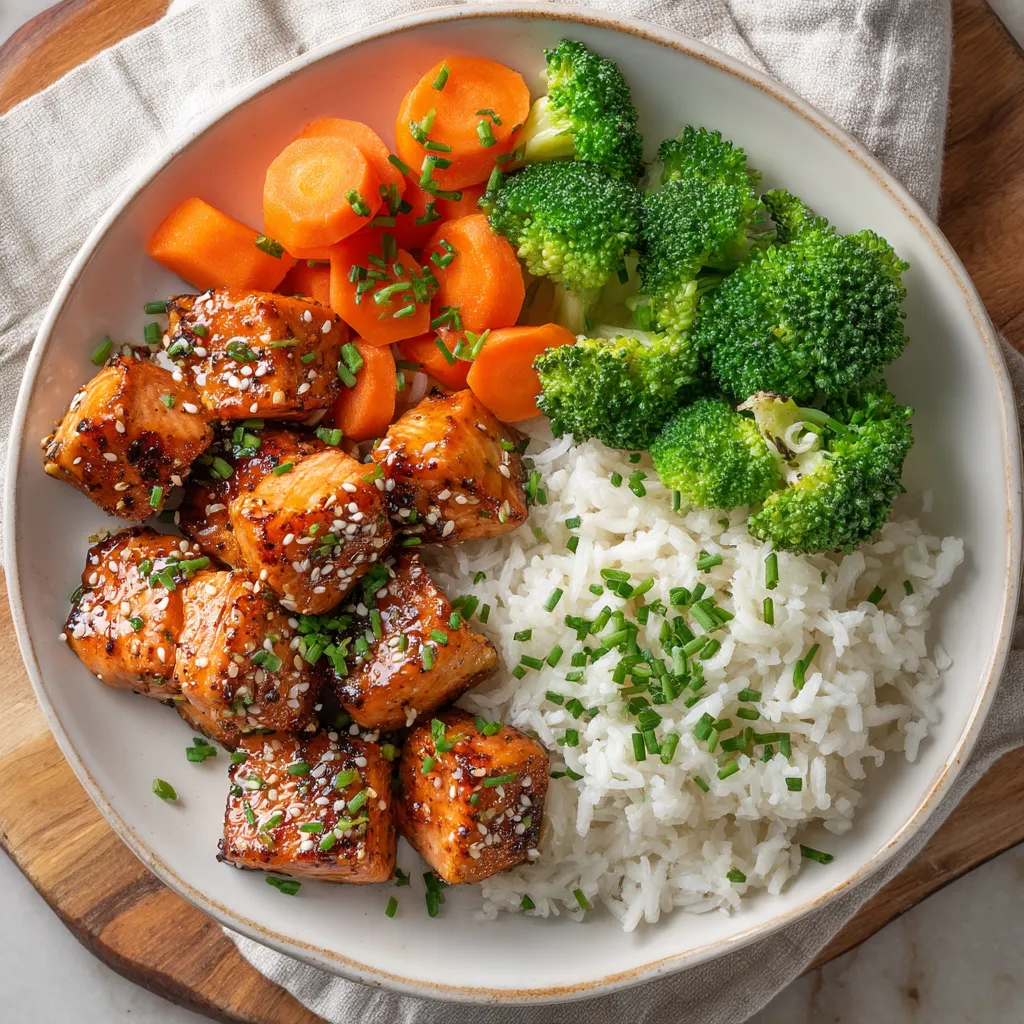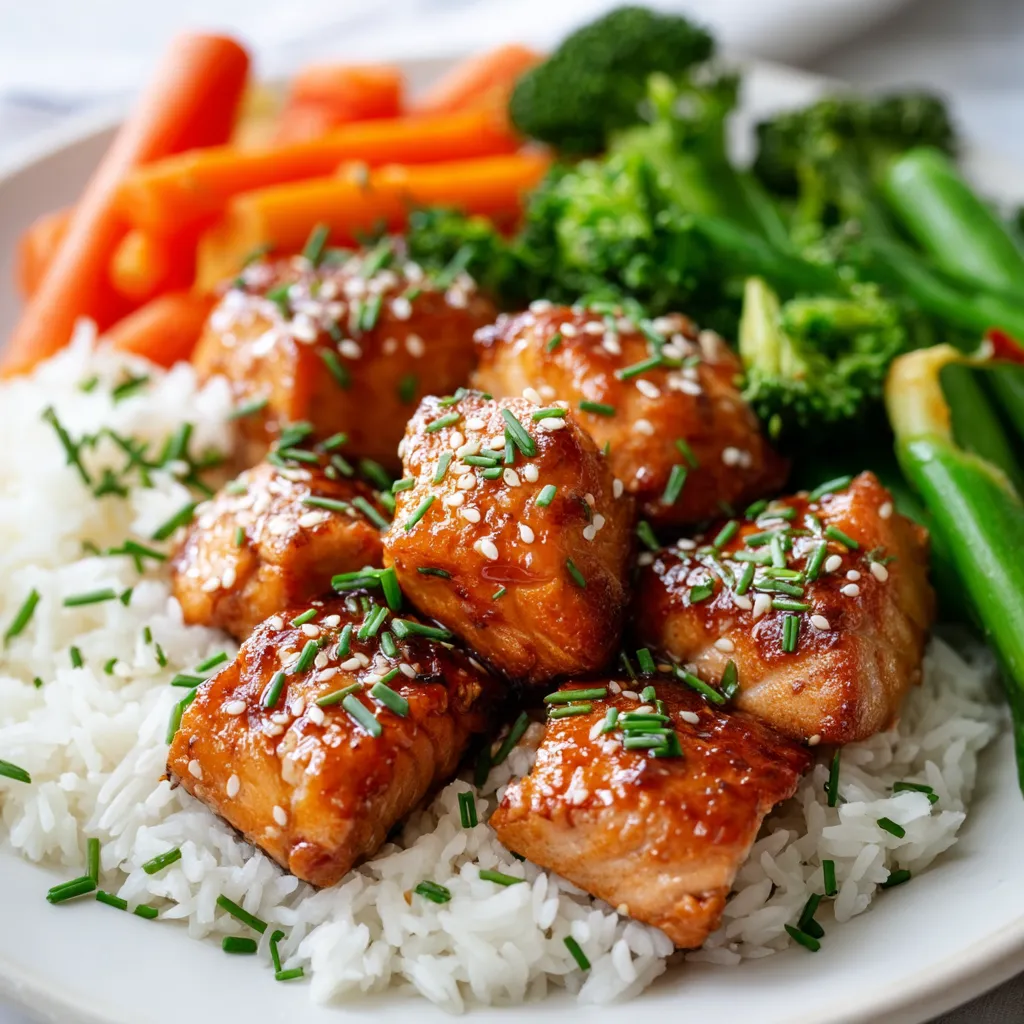 Save to Pinterest
Save to Pinterest This honey garlic salmon bites recipe transforms ordinary salmon into an irresistible dish with a perfect balance of sweet and savory flavors. The sticky honey glaze caramelizes around tender salmon pieces, creating a restaurant-quality meal that's surprisingly simple to make at home.
I discovered this recipe when looking for ways to make salmon more appealing to my seafood-hesitant friends. The first time I served it at a dinner party, everyone asked for the recipe before even finishing their plates.
Ingredients
- Salmon fillets: Skin removed and cut into 1inch cubes the star of the dish with its rich flavor and tender texture
- Paprika: Adds a subtle smoky flavor and beautiful color
- Garlic powder: Infuses the salmon with aromatic flavor without the risk of burning
- Onion powder: Provides savory depth without overpowering the delicate fish
- Salt and pepper: Essential for enhancing all the flavors
- Olive oil: Helps create a beautiful sear while preventing sticking
- Fresh minced garlic: Provides aromatic punch in the sauce
- Grated ginger: Adds warmth and complexity to balance the sweetness
- Soy sauce: Delivers umami richness and perfect saltiness
- Rice vinegar: Balances the sweet honey with gentle acidity
- Honey: Creates that irresistible sticky glaze while caramelizing beautifully
- Sesame seeds: Add a nutty crunch and visual appeal
- Chopped chives: Bring a mild onion flavor and bright color contrast
Step-by-Step Instructions
- Prep the Salmon:
- Pat salmon cubes completely dry with paper towels this step is crucial for achieving a good sear. Season liberally with paprika, garlic powder, onion powder, salt, and black pepper. Drizzle with about a tablespoon of olive oil and gently massage to ensure each piece is evenly coated.
- Sear to Perfection:
- Heat a heavy skillet until it's quite hot before adding a tablespoon of oil. Arrange salmon cubes in a single layer without overcrowding the pan this ensures proper browning rather than steaming. Cook for 4 to 5 minutes, carefully turning each piece until crispy and golden on all sides. Transfer to a plate and repeat with remaining salmon if needed.
- Create the Aromatic Base:
- In the same skillet you cooked the salmon, add the remaining oil over medium heat. Add minced garlic and grated ginger, sautéing for exactly one minute until fragrant but not browned. The residual salmon flavor in the pan adds depth to your sauce.
- Develop the Sauce:
- Pour in soy sauce, rice vinegar, and honey, stirring to combine and scrape up any flavorful bits from the bottom of the pan. Allow the sauce to bubble and simmer for 3 to 5 minutes, watching carefully as it thickens to a glossy consistency that will coat the back of a spoon. The sauce should reduce by about one third.
- Finish the Dish:
- Return the crispy salmon cubes to the skillet and gently toss to coat with the sticky sauce. The salmon should be just coated not drowning in sauce. Taste and adjust seasonings if needed, being careful not to break up the tender salmon pieces.
- Garnish and Serve:
- Transfer the glazed salmon to a serving plate and sprinkle with sesame seeds and freshly chopped chives. Serve immediately over fluffy rice with your favorite veggies for a complete meal.
 Save to Pinterest
Save to Pinterest The honey in this recipe is truly the magic ingredient. I once substituted maple syrup when I ran out of honey, and while still delicious, it lacked that signature caramelization that makes this dish so special. My family now requests this recipe at least twice a month, and I always make extra for lunch the next day.
Storage and Leftovers
This dish is best enjoyed fresh from the skillet when the salmon is perfectly tender and the sauce is at its stickiest. However, leftovers can be stored in an airtight container in the refrigerator for up to 2 days. To reheat, place in a covered skillet over medium-low heat with a splash of water to revive the sauce. Avoid microwaving as it can make the salmon tough and rubbery.
Perfect Pairings
While rice is the classic accompaniment, this honey garlic salmon works beautifully with many side dishes. Try it with coconut rice, quinoa, or even cauliflower rice for a lower-carb option. For vegetables, steamed broccoli, sautéed snap peas, or roasted asparagus complement the sweet-savory flavors perfectly. A simple cucumber salad with rice vinegar dressing offers a refreshing contrast to the rich salmon.
Make It Your Own
The basic recipe is wonderful as is, but there are many ways to customize it to your taste. Add a tablespoon of sriracha or a teaspoon of red pepper flakes for heat lovers. Replace the honey with brown sugar or maple syrup for a different sweetness profile. For a citrus twist, add the zest and juice of one orange or lime to the sauce. You can even transform this into a teriyaki-style dish by adding a tablespoon of mirin and reducing the honey slightly.
 Save to Pinterest
Save to Pinterest Common Recipe Questions
- → Can I use frozen salmon for this dish?
Yes, you can use frozen salmon, but ensure it's completely thawed and patted very dry before cutting into cubes. Excess moisture will prevent proper browning and create a steaming effect instead of the desired crispy exterior.
- → How do I know when the salmon is cooked properly?
The salmon cubes should be opaque throughout and flake easily with a fork. With 1-inch cubes, this typically takes 4-5 minutes in a hot skillet, turning occasionally. The exterior should be golden and slightly crispy while the interior remains tender and moist.
- → Can I make this dish ahead of time?
While best enjoyed fresh, you can prepare the components ahead of time. Season the salmon cubes and refrigerate for up to 8 hours. The sauce can be made in advance and gently reheated. Cook the salmon just before serving for optimal texture and flavor.
- → What sides pair well with honey garlic salmon?
Steamed jasmine or basmati rice makes an excellent base for absorbing the delicious sauce. For vegetables, consider steamed broccoli, asparagus, bok choy, or a simple mixed vegetable stir-fry. A light cucumber salad also provides a refreshing contrast.
- → How can I make this dish gluten-free?
Simply substitute regular soy sauce with tamari or certified gluten-free soy sauce. All other ingredients in the recipe are naturally gluten-free, making this an easy adaptation for those with gluten sensitivities.
- → Can I add vegetables directly to this dish?
Absolutely! Bell peppers, snap peas, broccoli florets, or sliced zucchini can be added to the skillet after removing the cooked salmon. Sauté them briefly before adding the sauce, then return the salmon to combine everything together.